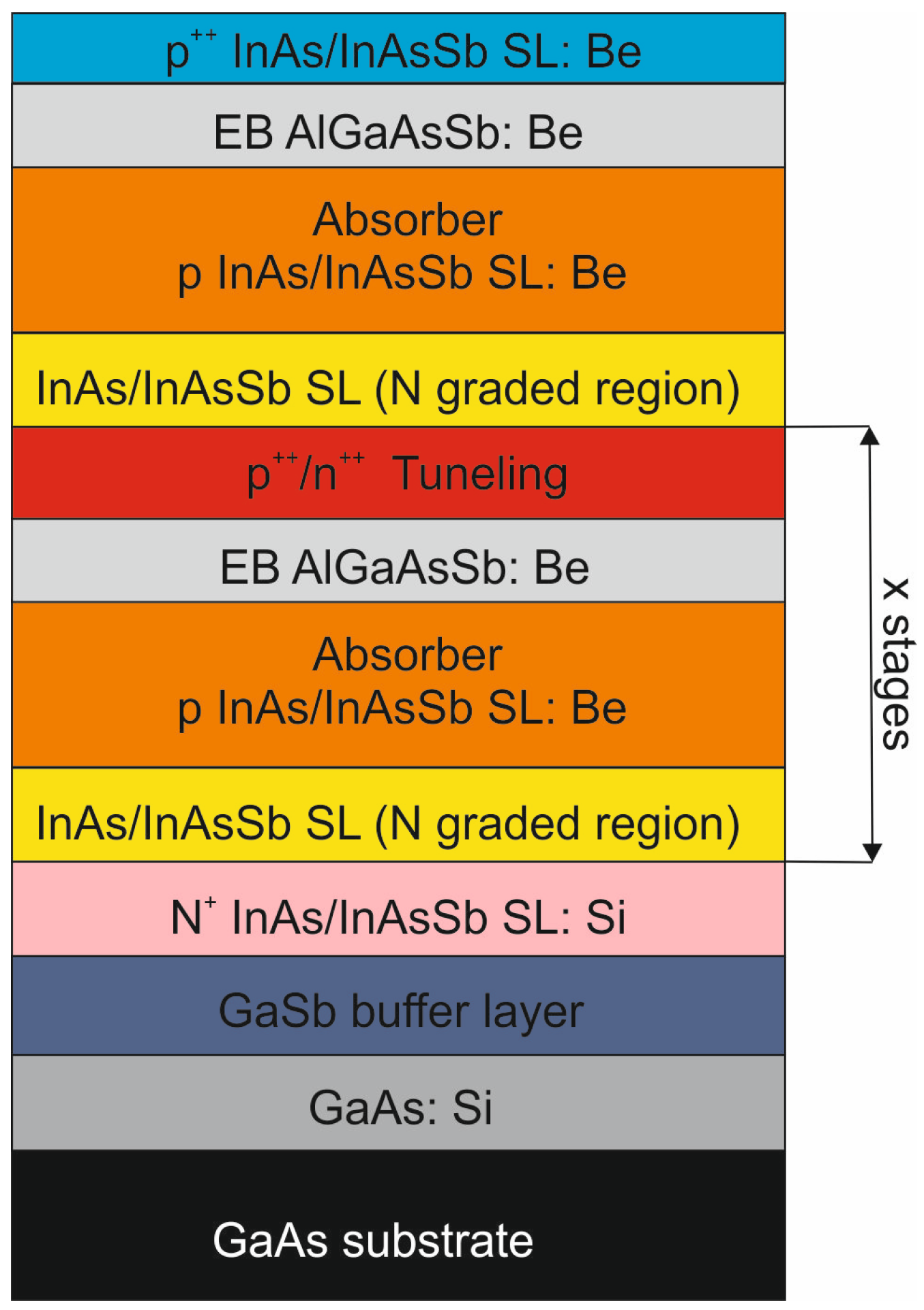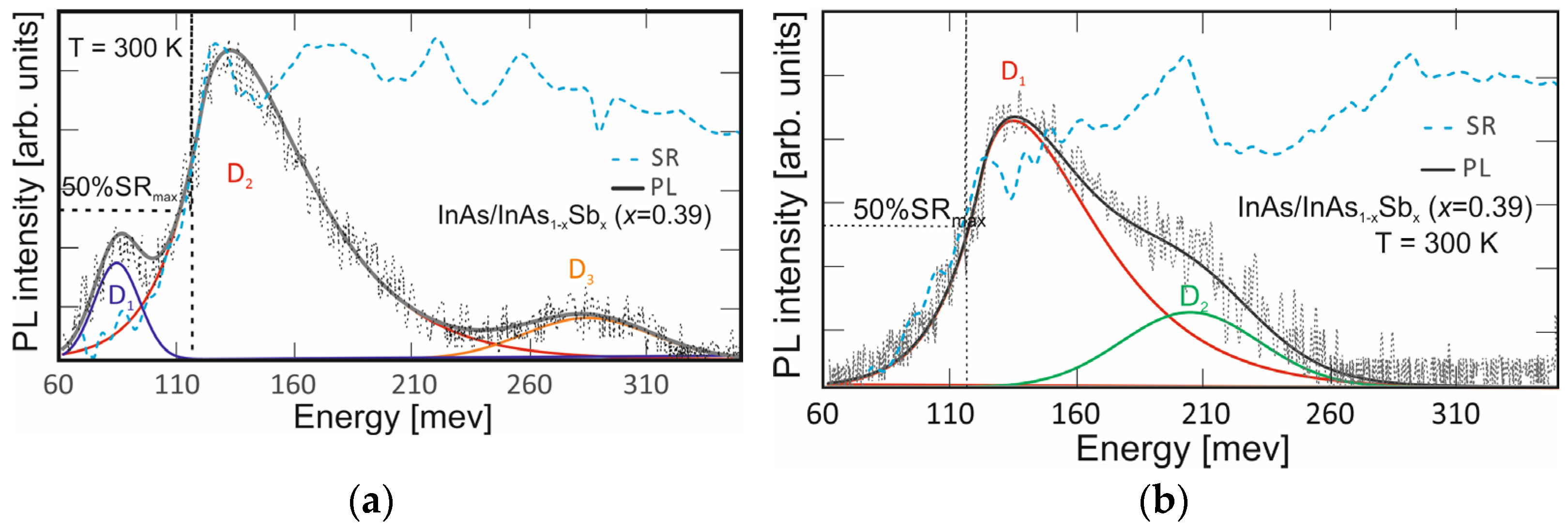LWIR Interband Cascade Photodetectors with InAs/InAsSb II Type Superlattice Absorber †
Abstract
1. Introduction
2. Detector Structure
3. Results and Discussion
4. Conclusions
Author Contributions
Funding
Institutional Review Board Statement
Informed Consent Statement
Data Availability Statement
Conflicts of Interest
References
- Klipstein, P.; Benny, Y.; Gliksman, S.; Glozman, A.; Hojman, E.; Klin, O.; Langof, L.; Lukomsky, I.; Marderfeld, I.; Nitzani, M. Minority carrier lifetime and diffusion length in type II superlattice barrier devices. Infrared Phys. Technol. 2019, 96, 155–162. [Google Scholar] [CrossRef]
- Soibel, A.; Ting, D.Z.; Khoshakhlagh, A.; Bouschet, M.; Fisher, A.M.; Pepper, B.J.; Gunapala, S.D. Hole diffusion length and mobility of a long wavelength infrared InAs/InAsSb type-II superlattice nBn design. Appl. Phys. Lett. 2024, 125, 171111. [Google Scholar] [CrossRef]
- Steenbergen, E.H.; Connelly, B.C.; Metcalfe, G.D.; Shen, H.; Wraback, M.; Lubyshev, D.; Qiu, Y.; Fastenau, J.M.; Liu, A.W.K.; Elhamri, S.; et al. Significantly improved minority carrier lifetime observed in a long-wavelength infrared III-V type-II superlattice comprised of InAs/InAsSb. Appl. Phys. Lett. 2011, 99, 251110. [Google Scholar] [CrossRef]
- Taghipour, Z.; Lee, S.; Myers, S.A.; Steenbergen, E.H.; Morath, C.P.; Cowan, V.M.; Mathews, S.; Balakrishnan, G.; Krishna, S. Temperature-Dependent Minority-Carrier Mobility in p-Type InAs/GaSbType-II-Superlattice Photodetectors. Phys. Rev. Appl. 2019, 11, 024047. [Google Scholar] [CrossRef]
- Martyniuk, P.; Rogalski, A.; Krishna, S. Interband quantum cascade infrared photodetectors: Current status and future trends. Phys. Rev. Appl. 2022, 17, 027001. [Google Scholar] [CrossRef]
- Lei, L.; Li, L.; Ye, H.; Lotfi, H.; Yang, R.Q.; Johnson, M.B.; Massengale, J.A.; Mishima, T.D.; Santos, M.B. Long wavelength interband cascade infrared photodetectors operating at high temperatures. J. Appl. Phys. 2016, 120, 193102. [Google Scholar] [CrossRef]
- Benyahia, D.; Michalczewski, K.; Hackiewicz, K.; Kębłowski, A.; Martyniuk, P.; Rutkowski, J.; Piotrowski, J. Molecular beam epitaxy growth and characterization of interband cascade infrared detectors on GaAs substrates. J. Cryst. Growth 2020, 534, 125512. [Google Scholar] [CrossRef]
- Gawron, W.; Kubiszyn, Ł.; Michalczewski, K.; Piotrowski, J.; Martyniuk, P. Demonstration of the longwave type-II superlattice InAs/InAsSb cascade photodetector for high operating temperature. IEEE Electron. Device Lett. 2022, 43, 1487–1490. [Google Scholar] [CrossRef]
- Murawski, K.; Majkowycz, K.; Kopytko, M.; Manyk, T.; Dąbrowski, K.; Seredyński, B.; Kubiszyn, Ł.; Martyniuk, P. Optical Characterization of the Interband Cascade LWIR Detectors with Type-II InAs/InAsSb Superlattice Absorber. Nanomaterials 2024, 14, 1393. [Google Scholar] [CrossRef] [PubMed]
- Birner, S. Modeling of Semiconductor Nanostructures and Semiconductor-Electrolyte Interfaces. Ph.D. Thesis, Walter Schottky Institut, Technische Universität München, München, Germany, 2011. [Google Scholar]
- Murawski, K.; Kopytko, M.; Madejczyk, P.; Majkowycz, K.; Martyniuk, P. HgCdTe energy gap determination from photoluminescence and spectral response measurements. Metrol. Meas. Syst. 2023, 30, 183–194. [Google Scholar] [CrossRef]


Disclaimer/Publisher’s Note: The statements, opinions and data contained in all publications are solely those of the individual author(s) and contributor(s) and not of MDPI and/or the editor(s). MDPI and/or the editor(s) disclaim responsibility for any injury to people or property resulting from any ideas, methods, instructions or products referred to in the content. |
© 2025 by the authors. Licensee MDPI, Basel, Switzerland. This article is an open access article distributed under the terms and conditions of the Creative Commons Attribution (CC BY) license (https://creativecommons.org/licenses/by/4.0/).
Share and Cite
Murawski, K.; Majkowycz, K.; Manyk, T.; Kopytko, M.; Michalczewski, K.; Jureńczyk, J.; Kubiszyn, Ł.; Seredyński, B.; Martyniuk, P. LWIR Interband Cascade Photodetectors with InAs/InAsSb II Type Superlattice Absorber. Proceedings 2025, 129, 69. https://doi.org/10.3390/proceedings2025129069
Murawski K, Majkowycz K, Manyk T, Kopytko M, Michalczewski K, Jureńczyk J, Kubiszyn Ł, Seredyński B, Martyniuk P. LWIR Interband Cascade Photodetectors with InAs/InAsSb II Type Superlattice Absorber. Proceedings. 2025; 129(1):69. https://doi.org/10.3390/proceedings2025129069
Chicago/Turabian StyleMurawski, Krzysztof, Kinga Majkowycz, Tetiana Manyk, Małgorzata Kopytko, Krystian Michalczewski, Jarosław Jureńczyk, Łukasz Kubiszyn, Bartłomiej Seredyński, and Piotr Martyniuk. 2025. "LWIR Interband Cascade Photodetectors with InAs/InAsSb II Type Superlattice Absorber" Proceedings 129, no. 1: 69. https://doi.org/10.3390/proceedings2025129069
APA StyleMurawski, K., Majkowycz, K., Manyk, T., Kopytko, M., Michalczewski, K., Jureńczyk, J., Kubiszyn, Ł., Seredyński, B., & Martyniuk, P. (2025). LWIR Interband Cascade Photodetectors with InAs/InAsSb II Type Superlattice Absorber. Proceedings, 129(1), 69. https://doi.org/10.3390/proceedings2025129069





